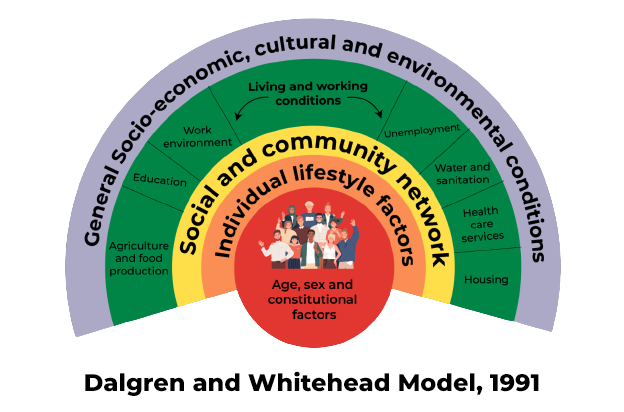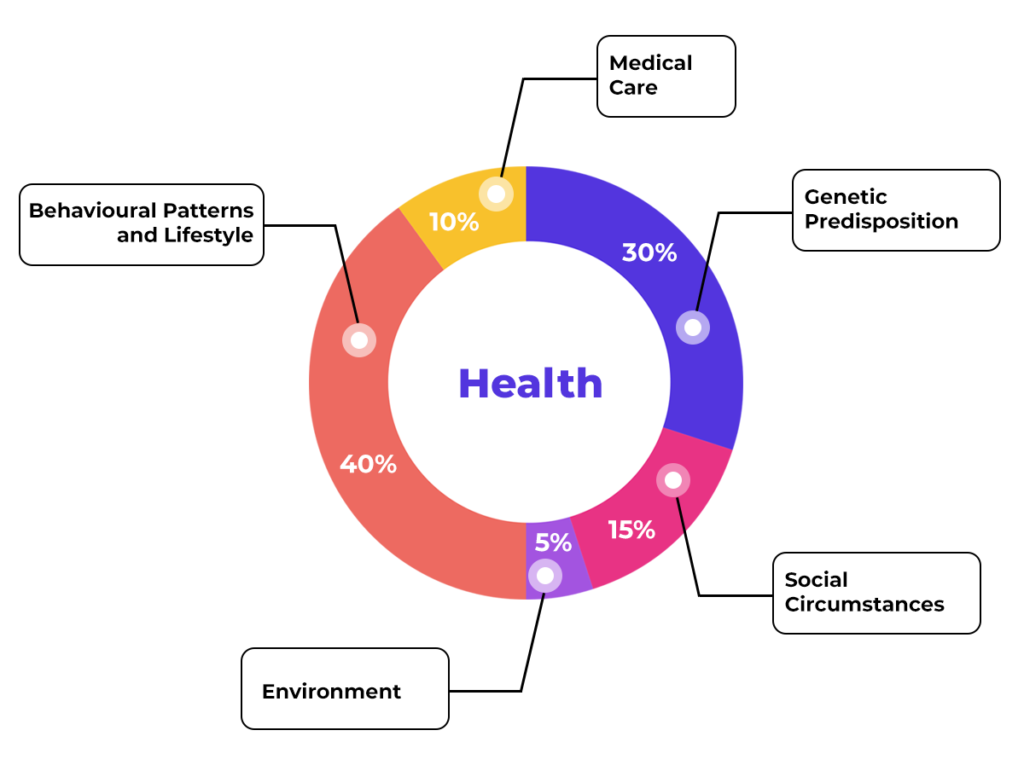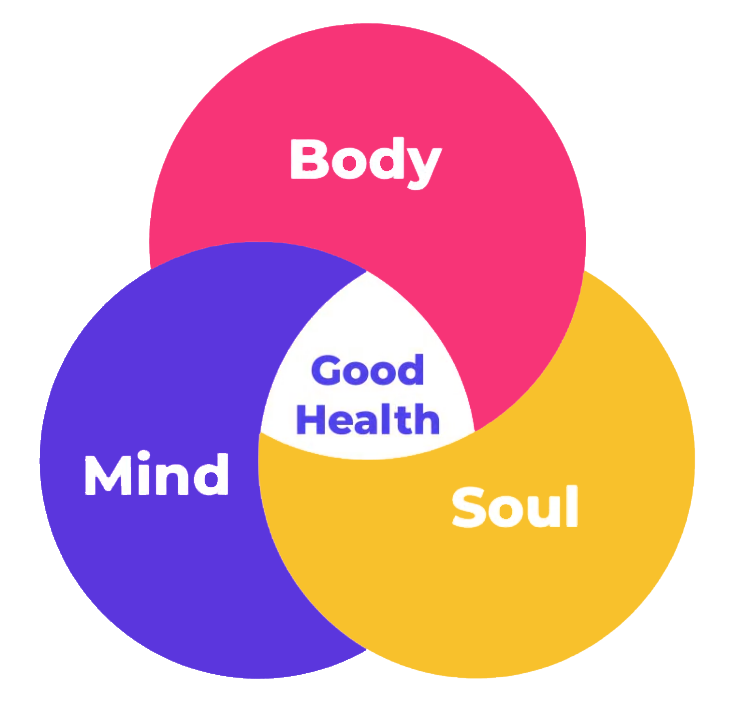Key Elements of Health


Nasreen Hasan
October 9, 2023
Rethinking Health
Quick! picture a healthy person.
Perhaps you thought of an athlete, or someone muscular, or thin. Probably the person you came up with was young. But is this the only way to be healthy? Can someone be old and healthy, or overweight and healthy? Can someone be muscular or thin and unhealthy? And is health only related to physical attributes. Can someone have peak physical conditioning and still be unhealthy in other areas?
Once we think about it a little, it seems obvious that “health” is a lot more involved and complex than we might assume.

Factors Influencing Health and Well-being
The World Health Organization states that “The ability to attain the highest standard of health is a basic human right” – however health is shaped by an intricate interplay of biological, behavioral, environmental, social, and economic factors, all linked to one another. This intricate web of influences was first modeled in the early 1990s by Dahlgren and Whitehead in what is commonly referred to as the “Rainbow Model”.

The Rainbow Model identified five different levels of health determinants – individual, social, political, economic and cultural. It showed how these interrelated influences can affect an individual’s overall state of health in both positive and negative ways. For example, access to health care, healthy food options, and educational resources are all social determinants that have a profound effect on the physical and mental health of an individual. On a larger scale, economic policies such as taxation or trade can have a major influence on our collective health outcomes. In addition environmental factors such as pollution and extreme weather also determine health.
At the core of the model, health is determined by biology and constitutional factors – genetics, innate characteristics, age and sex. This is something we have little to no control over. At the other extreme is the general socio-economic, cultural and environmental conditions. Again as individuals we have very little control over these factors – they are a consequence of where and when we were born.
In between these two extremes is the individual level of health determinants – where we can make lasting changes. This includes education, lifestyle choices and access to social support networks. Improving the quality of life in these areas can help us maintain a healthy lifestyle and enjoy better physical and mental health.
Exploring the Balance between Individual Choices and External Influences
But what percentage of health is determined by our individual choices and what percentage is predetermined by genetics, age and sex? And how much are we influenced by the social and environmental factors around us?
These are all difficult questions to answer as there is no one-size-fits-all approach when it comes to health. One study shows that in the US, on average the impacts of different health determinants that influence well-being and longevity are as follows (Graham and White, 2016):

However, it is important to note that these figures may only be applicable to the US or countries with similar socioeconomic, cultural and environmental conditions. For instance, in a country plagued by drought or famine, the environmental exposures and social circumstances play a much larger role in determining health outcomes. Likewise a person born with a limiting genetic disease will be more heavily impacted by their genetic predispositions.
The Role of Individual Circumstances and Social Justice
It is also important to remember that everyone’s individual circumstances are different and that we should all strive for an approach that works best for us when it comes to our own health, whether this means making small changes or taking more drastic steps.
Everyone deserves the right to access healthcare and resources that will help them to live a healthy, happy life. However, individual circumstances can impact people’s ability to access required resources. Inequalities related to gender, socio-economic status and race can act as a barrier to health, creating an unjust gap in outcomes such as life expectancy and quality of life. To combat this, it is essential that we also strive for greater social justice and address the systemic issues which create these disparities in access to resources, so that everyone can enjoy the same level of health and well-being.
Understanding People’s Definitions of Health
To gain deeper insights into people’s understanding of health, we conducted a series of focus groups and interviews within our community. Through these interactions, participants shared their unique perspectives on what health truly means to them and what they consider vital for maintaining a well-rounded, healthy lifestyle. The prevailing viewpoint emphasized that health encompasses not only physical well-being but also mental and emotional wellness—an all-encompassing state of being that our participants aptly described as the harmonious unity of Body, Mind & Soul.

- Physical – Body: Physical fitness encompasses more than just the absence of disease. It entails freedom from pain or physical disability, as well as the capability to independently engage in daily activities. Achieving and maintaining optimal physical well-being is vital for a fulfilling and vibrant life.
- Mental – Mind: Achieving mental clarity and maintaining good mental health are crucial. It goes beyond just the absence of mental illness; it involves being mindful of our thoughts and emotions, actively engaging with them, and using them to shape our feelings, thoughts, and actions in meaningful ways. This includes the ability to focus, concentrate, and maintain emotional balance, ultimately leading to a more fulfilling and balanced life.
- Emotional – Soul: Life satisfaction encompasses living one’s life in a manner that provides a sense of purpose and meaning. It involves feeling connected to something greater, being an integral part of a community, and building meaningful relationships that bring joy and fulfillment.
Modifiable Lifestyle Behaviors
The Common Building Blocks of Health
Focusing on behaviors that optimize each of these three components may initially feel overwhelming. However, during our participants’ discussions on factors and behaviors that influence the mind, body, and soul, they discovered a significant amount of overlap. It is evident that numerous factors that promote physical well-being, such as consistent exercise and adopting healthy eating habits, also have a positive impact on mental health. Similarly, engaging in activities which bring joy and fulfillment can help us stay motivated to maintain physical fitness and improve our overall sense of well-being.
The participants brainstormed more than 100 factors that affect health. They then narrowed them down to the ones they believed they could control. We further consolidated these factors into a handful of key behaviors that both had a significant impact on their health and were within their control. This ultimately boiled down to Movement, Food, Hydration, Sleep, Nature/Sunlight, Avoiding Alcohol & Smoking, and Spirituality. Spirituality means different things to different people – it may include community, purpose, meaning, meditation, mindfulness and faith – all contributing to a deeper connection with the self and the world around us.
Applying the Building Blocks of Health to Your Own Life
Ultimately, it is evident that our personal choices and lifestyle habits play a significant role in maintaining our well-being and happiness. However, what influences these choices? Moreover, which lifestyle behaviors have the greatest impact on our health? The demands of a hectic and stressful life can make it challenging to change all aspects of our lives at once, so which small changes can we make to get the biggest benefit? and how can we make the healthier choice the easy one?
In the weeks to come, we will delve into these topics and uncover their profound impact on our overall well-being.. So join us as we take a deep dive into how these different factors influence our overall well being.
Join the Conversation
If you have any questions or would like to know more about how different factors determine our health please don’t hesitate to reach out. If you would like to contribute to our research please join our focus groups and fill in our online health survey.
Disclaimer: The information including but not limited to text, graphics, images and video is for informational purposes only. It is not intended as a substitute for professional medical advice, diagnosis, or treatment. Always seek the advice of your physician regarding medical conditions, treatment, and before undertaking a new healthcare regiment.
References:
Dahlgren, G., & Whitehead, M. (2021). The Dahlgren-Whitehead model of health determinants: 30 years on and still chasing rainbows. Public health, 199, 20-24.
Graham, H., & White, P. C. (2016). Social determinants and lifestyles: integrating environmental and public health perspectives. Public health, 141, 270-278.
Speller, V. (2013). Collective and individual responsibilities for health, both physical and mental.

